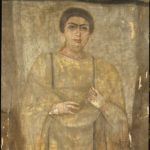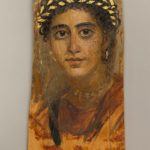Profile
Ivory Bangle Lady
The Historian
-
The historian championing this figure
I'm Dr. Liz Gloyn and I'm a Reader in Latin Language and Literature at Royal Holloway, University of London. I spend most of my time thinking about people who lived in the first centuries BC and AD; I'm particularly interested in philosophy and drama. I'm also interested in what happens to things from the classical world when people in the modern world use them for their own purposes, and I recently wrote a book on classical monsters in popular culture.
-
What was the time period like?:
The fourth century AD marked the move towards the beginning of the end of Roman occupation of Britain. In 367 AD Hadrian’s Wall was abandoned. In 383 AD, Roman troops were withdrawn from north and western Britain, and in 406 AD the emperor Honorius told cities in Britain to defend themselves against attackers, essentially telling them they were on their own. While there was a lot more unrest and attacks from groups like the Picts and Saxons, the withdrawal of the Romans was very gradual. The change from being formally part of the Roman empire would have been slow, especially since Britain had already been under independent rule at the end of the third century until it was reclaimed by Constantius I, who died at York (Eboracum) in 306 AD.
Until the Romans left, Britain was a province of the Roman empire. A province was an area ruled by a governor or a prefect, who then reported to the emperor. In the fourth century, the system of government changed many times, including several periods where there were joint emperors, one based in the west of the empire and one based in the east.
Because we can’t put specific dates on when the Ivory Bangle Lady lived and died, it’s hard to know whether she would have seen any of the major events that took place during the fourth century. She could have seen Magnentius’ attempted take-over of the imperial throne in 350, which attracted a lot of support from Britain. She might have lived through the abandonment of Hadrian’s Wall in 367 and the raiding that took place that year, as well as the arrival of Theodosius and his army to restore order in 368. She might even have lived through Magnus Maximus’ usurpation (or theft) of the imperial throne in 383, which started when the troops he was commanding in Britain proclaimed him emperor, although he eventually was captured and executed in Italy in 387, so didn’t last long. Whenever she lived, she was likely to have known about a lot of insecurity and conflict, even if it took place away from York.
We can’t say much about what life was like for Black people in this time period, because their experiences were so different. People with African heritage came to Britain particularly because of their links to the Roman army, perhaps as dedicated military units raised in the African provinces, or as descendants of those had settled elsewhere in the empire. We can tell that Black people moved around the Roman empire from the chemicals in their bones and teeth, and we can tell whether they had to do hard physical work or not from their skeletons. Our evidence tells us that you could find Black people at all levels of Roman British society, even if they were only there in very small numbers.
-
What influence have they had on Modern Day UK?:
The Ivory Bangle Lady herself didn’t do anything to change the world we live in today, but she tells a bigger story about people moving around the Roman empire a lot more than we used to think possible.
The impact she has made in the modern world mainly comes from how new studies on her bones and teeth have changed how we understand the Roman world and the presence of Black people in it. In particular, she makes us remember that while slavery existed during the Roman period, people were not enslaved solely because of the colour of their skin.
-
Born: Somewhere between 325 and 380 AD
-
Died: Second half of the fourth century AD (between 350 and 400 AD)
-
Time period:
The Ivory Bangle Lady lived in Roman Britain during the fourth century AD.
-
Short Bio: The Ivory Bangle Lady lived in Roman Britain during the fourth century AD. Some members of her family came from North Africa. She grew up in either western Britain or in Europe. She moved to York, where she died between the ages of 18 and 23. The things buried with her show she was a rich woman, who may have been connected with the Roman army or with traders. We don't know much about her life, but we can make some sensible guesses based on what she was buried with and what we know about Roman York when she lived there.
-
Extra resources:
Content note: most of these links contain images of human remains.
Scholarship
The major study of the Ivory Bangle Lady is open access (that is, anyone can download the PDF and read it without paying any money). It is an academic article written for other archaeologists and historians, so there’s a lot of technical language and it’s quite complicated.
Everything you need to know about… International Roman York In One Minute – Youtube video from the York Museums Trust
Roman York – Meet The People Of The Empire – Youtube video from the York Museums Trust
Articles From Around The Internet
Ivory Bangle Lady – the Yorkshire Museum page about the Ivory Bangle Lady and her grave goods.
Celebrating Ivory Bangle Lady – the York Museums Trust explains more.
Roman remains in York are ‘elite’ African woman – BBC News story from 2010 reporting the new study.
Digging Up Migration History: The Ivory Bangle Lady – a post by the Runnymede Trust for Black History Month in 2017.











